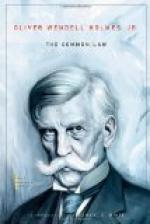In old times a use was a chose in action,—that is, was considered very nearly from the point of view of contract, and it had a similar history to that which has been traced in other cases. At first it was doubted whether proof of such a secret trust ought to be allowed, even as against the heir. 1 It was allowed, however, in the end, 2 and then the principle of succession was extended to the assign. But it never went further. Only those who were privies in estate with the original feoffee to uses, were bound by the use. A disseisor was no more bound by the confidence reposed in his disseisee, than he was entitled to vouch his disseisee’s warrantor. In the time of Henry VIII. it was said that “where a use shall be, it is requisite that there be two things, sc. confidence, and privity: ... as I say, if there be not privity or confidence, [408] then there can be no use: and hence if the feoffees make a feoffment to one who has notice of the use, now the law will adjudge him seised to the first use, since there is sufficient privity between the first feoffor and him, for if he [i.e. the first feoflor] had warranted he [the last feoffee] should vouch as assign, which proves privity; and he is in in the per by the feoffees; but where one comes into the land in the post, as the lord by escheat or the disseisor, then the use is altered and changed, because privity is wanting.” 1
To this day it is said that a trust is annexed in privity to the person and to the estate 2 (which means to the persona). It is not regarded as issuing out of the land like a rent, so that while a rent binds every one who has the land, no matter how, a disseisor is not bound by the trust. 3 The case of the lord taking by escheat has been doubted, 4 and it will be remembered that there is a difference between Bracton and later authors as to whether he comes in as quasi heres or as a stranger.
Then as to the benefit of the use. We are told that the right to sue the subpoena descended indeed to the heir, on the ground of heres eadem persona cum antecessore, but that it was not assets. 5 The cestui que use was given power to sell by an early statute. 6 But with regard to trusts, Lord Coke tells us that in the reign of Queen Elizabeth [409] all the judges in England held that a trust could not be assigned, “because it was a matter in privity between them, and was in the nature of a chose in action.” 1 Uses and trusts were both devisable, however, from an early day, 2 and now trusts are as alienable as any form of property.
The history of early law everywhere shows that the difficulty of transferring a mere right was greatly felt when the situation of fact from which it sprung could not also be transferred. Analysis shows that the difficulty is real. The fiction which made such a transfer conceivable has now been explained, and its history has been followed until it has been seen to become a general mode of thought. It is now a matter of course that the buyer stands in the shoes of the seller, or, in the language of an old law-book, 3 that “the assign is in a manner quasi successor to his assignor.” Whatever peculiarities of our law rest on that assumption may now be understood.




